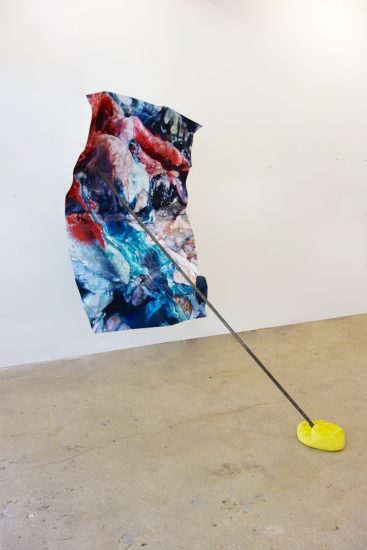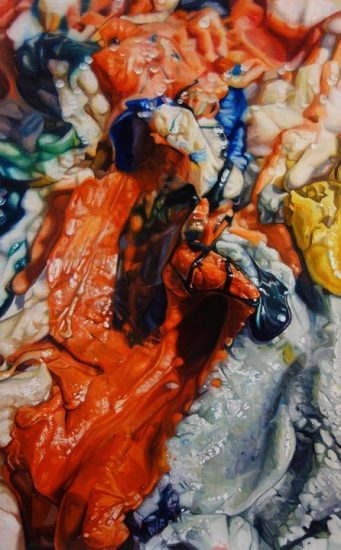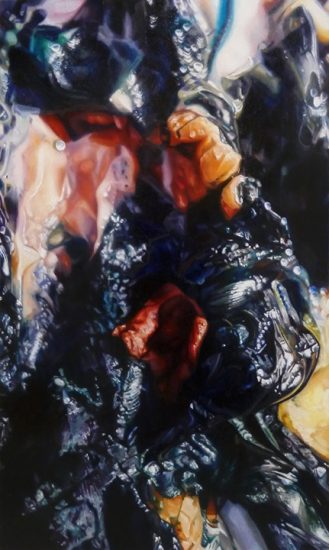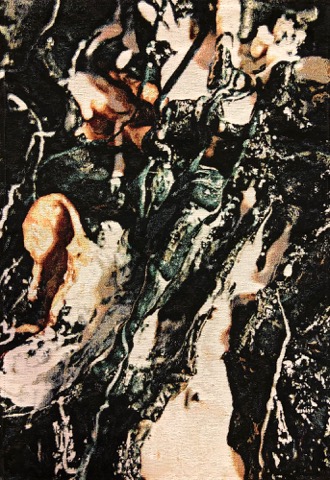Australian-Irish artist Lisa McCleary, now resident in New York, discusses her upcoming solo show at Gallery MC, eroticism, surfaces, sci-fi and insane amounts of hard work…
Andrew Frost: The last time I saw you, you were about to graduate from the Honors year at UNSW Art & Design, and now you’re in New York with another degree, and a new solo show on the horizon. It seems like you’ve had a pretty exciting adventure. Could you talk about how you came to be there?
Lisa McCleary: It’s definitely been a busy and exciting few years. After moving from Ireland to Australia to complete my BFA at UNSW AD I knew I really enjoyed engaging with a different culture and could see that the experience had a positive influence on my practice. In 2016 I was accepted to the Master of Fine Arts Program at Parsons, The New School, NYC. I couldn’t believe that I would get to experience the NY art world, it was overwhelming and I was very honored to be accepted. The Parsons MFA Program offers 20 students a unique opportunity to have a studio in Manhattan while learning alongside a wide range of international and national artists. Masters Programs in the US are structured very differently to Aussie ones, intense hours, a lot of course work and constant critiques. It toughens you up, much like New York at large.
Since I graduated last March I have been exhibiting nationally and have been fortunate enough to receive a space at four different US art residencies. I just completed the Art & Law Programin Manhattan, lead by attorney Sergio Muñoz Sarmiento. It is a seminar that focuses on the study of law, with an emphasis on how its discourses and practices impact visual culture, self-governance, and history. It was fascinating to use legal texts, structures and modes of thought to critique current artistic, curatorial and theoretical practices. Next month I will be undertaking the Vermont Studio CenterResidency for which I received their VSC grant. I realize how fortunate I have been to experience the art world in New York and I haven’t taken it for granted. I’ve been working non-stop to experience all that I can while in the States.

AF: How did the new show at Gallery MC come about? What was the work that has led up to it?
LMcC: In 2018 I was selected for two international group exhibitions at Gallery MC, Art on 52nd St.and Show Your World. I established a relationship with the gallery and I was fortunate enough to be offered a solo show in their main exhibition space. Gallery MC is very dynamic as it exhibits a lot of international artists. It provides opportunities to apply for open calls and brings a diverse range of art from all over the world. But even preparing works for the show, it all feels a bit surreal; I always dreamed of one day having a solo exhibition in New York, I can’t believe it’s a reality. For the past few years, through my interdisciplinary practice, I have created a space in which pleasure, agency, desire and the digital and real body are in play. My work has recently transformed from representational figurative realism to taking a more abstracted approach to the body and visceral pleasure. The series of works I will be exhibiting in my upcoming solo show Edgingaddress haptic sensations and the representation and embodiment of touch. I am interested in the pleasure of flesh and the way that that translates into our desire for our communication devices, and our tactile relationship to industrial materials.
AF: It’s seems to me one of the key aspects of this new body of work is the engagement with materials – oil paint on aluminium. What drew you to that process and what are its challenges?
LMcC: The fortunate thing about my Masters Program is that they provided a lot of different facilities for artists to use. I was introduced to the metal shop, plasma cutter and welder and really appreciated the opportunity to experiment with new methods and materials. Creating a structure from steel or aluminum was a completely different experience, very physical and engaging. I became much more aware of my body in the process of production. I was intrigued by the required amount of force to affect the surface and how materials reacted to pressure, such as metal sheets buckling if too much heat was applied. I utilize the weight of steel and industrial materials to question feminine stereotypes.
This series of new works refers to screen culture and mediated corporeality so I was drawn to aluminum for its thin cold industrial feel. There’s no weight or body to the material, it feels like a thin sheet of mechanical skin. I utilize the Trompe L’eoil effect in my paintings, creating illusionistic depth in the rendered landscapes, and I like how the paper-thin sheet of aluminum counterbalances that. I want to mirror the way we receive images on the screen. While there may be representations of touch, there may actually be nothing to feel. Painting on aluminum is a lot of trial and error: sanding, degreasing, priming. There’s a lot of preparation for any paint to stick to the surface. I appreciate that it’s complicated.

AF: Your writing about the paintings discusses them as being richly metaphorical, drawing connections between their surface and to human skin. How does that sort of thinking help you through the process of making?
LMcC: Much like aluminium, the skin takes a lot of wear and tear. I think that conflating the flesh and industrial materials can create possibilities of some kind of mechanical anthropomorphic being. Corp agus Fuil/Body and Blood depicts a realistically painted, oozing Play Doh landscape that recalls the visceral corpus of the body. It looks towards BDSM and the dynamics of sexual play, demonstrating a liminal moment of an impact play scene. The painting, which proclaims orgasm, is the masochist, while the rod functions as the sadist, signifying a gesture of consensual force to wanting body.I consider the ability of the industrial materials; the bends and folds in the aluminium surface have a direct relationship to force from the body. The writhing tableau and twisted aluminum appears as if it is floating off the wall, caught in a moment of pleasurable rapture. I appreciate the range of possibilities for materials, and how notions of the body can be rendered through paint or embodied through 3-Dimensional surfaces that encroach on the viewers’ physical space
AF: Can you talk about the sci-fi and fantasy aspect of the work? How do those ideas inform the work? And where did that interest come from?
LMcC: My work for the past four years has considered different aspects of human sexuality, the real and virtual body and screen culture. What I enjoy about science fiction is the vision of possible futures and alternate realities a few steps from our current climate. I find that fiction that is only slightly removed from where we are socially, politically and technologically situated is often the most chilling. I appreciate sci-fi that approaches the potentiality of technology and AI, what we are advancing towards and what kind of effect that will have on our culture and the way we relate to one another. I have a great mentor, Peter Rostovsky who introduced me to the overlap between art and sci-fi and broadened the way I approach my works.
Conceptually I was considering the very tangible and physical practice of BDSM impact play and the pleasurable capabilities of affected flesh. The body becomes a medium for mark making and a vessel of haptic sensations. How do we touch bodies to give or receive pleasure? And how are those embodied practices vastly different to the way we communicate our sexual desires through the screen? There’s a distance, a filter of technology and a flat surface, much like the myriad screens I use to produce each of my pieces. What would happen if the real and the virtual could be further integrated? What if as we stroked our screen it directly affected another body? What if in some future vision the screen is the body? Taking the idea of a touch screen and amplifying it. Something along the lines of a viscerally intriguing and disturbing episode of Black Mirror.

AF: There is a definite technological aspect to the work, and the way the paintings are pinned or lent against walls also suggests a kind of restraint, or limitation. What’s the thinking behind that?
LMcC: I like to play with the way we encounter the painted surface. The flat screen-like paintings are mounted an inch or so off the wall, which creates the illusion that they are floating screens. The empty space behind the piece and the shadow it casts add to the technological sci-fi feel of the works. My larger piece Corp agus Fuil/Body and Bloodappears as if it has been restrained against the wall by the force of the heavy threaded rod. The 8ft painting towers over the viewer and buckles around the point of impact. I was considering the reaction of a body to pleasurable force and the dynamics of BDSM: restraint, limitations, impact, performance, and gesture. When encountered by the public it is very common for the viewers to ask how my pieces appear to be floating or to try and peer behind the screens to understand how the works are mounted to the wall. I like to challenge the conventions of painting through my play with materials, installation or intervention with the painted surface.

AF: You talk about the work as ‘alluding to eroticism’ and in particular, the sexual practice of edging. What does this mean in relation to the formal qualities of the paintings, but also to the ideas of technology and sci-fi?
LMcC: My work explores a corporeal connection to flesh through imagery of abject bodily landscapes that is both seductive and repulsive. The erotic quality of the oozing landscapes and wet folds of metaphorical flesh suggest sexual arousal. The manner in which I photorealistically render the images onto the flat aluminium planes gives the paintings a high gloss photography feel, which adds to the lustrous and erotic quality of the works. The illusionistic painting techniques I employ suggest that there is something to potentially touch when in actuality the works are 2-dimensional representations of the tactile and deny the viewer the full pleasure of experiencing the haptic and the real; much like how we experience imagery online.
Edging is a sexual practice that focuses on the communication of bodily desire and arousal to another in order to reach overwhelming sexual euphoria. It mirrors my practice through my interest in the tactile sense, the body, communication of pleasure, and the start and stop motion of my means of production to reach the final form which proclaims orgasm. For me the concept of edging is about power play: giving the control over your body to another for enjoyment. It can also be about the denial of pleasure. I feel like the practice of edging relates to the way we experience the tangible world through technology. We give our power over to another medium for our enjoyment, but in doing so we may be denied pleasure. Technology moves us closer together and further away from one another, while there may be visual representations of touch we are withheld the full satisfaction of experiencing the real and the palpable.

Pingback: Fine Arts Alum Lisa McCleary Interviewed By The Art Life |